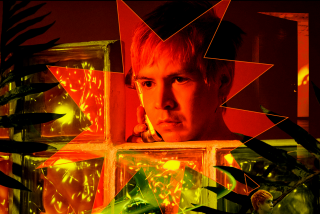For love of ‘Where the Wild Things Are,’ director Spike Jonze goes long
Spike Jonze’s adaptation of “Where the Wild Things Are” turns the slimmest of books -- 10 sentences, 18 pictures -- into a feature-length film. This feat of expansion is perhaps all the more surprising when you consider the director’s track record -- in music videos, skate videos, short films, commercials and various off-the-cuff goofs and larks -- as a miniaturist par excellence.
“Wild Things,” out on standard and Blu-ray DVD this week, is only Jonze’s third feature in a decade, and it’s clearly a labor of love. In fleshing out the adventures of young Max (played by newcomer Max Records), Jonze and co-screenwriter Dave Eggers preserve the mysterious sense of delight and danger that defined Maurice Sendak’s 1963 children’s classic. The furry wild things, undifferentiated in the book, are given names and personalities, and brought to life through an elaborate process combining puppetry, digital animation and voice work.
But as labor-intensive as it was, “Wild Things” is hardly the only project that has been occupying Jonze since 2002’s “Adaptation.” While the industry norm dictates that filmmakers graduate from calling-card shorts to feature-length assignments, he continues to work and thrive in the short form. Within the last few months alone, he has premiered two new shorts every bit as inventive as “Wild Things.”
“We Were Once a Fairytale,” available on iTunes, is a 12-minute collaboration with a self-spoofing Kanye West, who plays “Drunk Kanye” rampaging through a club and eventually purging the demonic rodent in his stomach. (Produced before last September’s MTV Video Music Awards, it now seems to presage West’s notorious outburst.) The half-hour “I’m Here,” a lovely, dark-edged story of the fraught romance between two robots, overshadowed most of the features at Sundance last month.
It’s fitting that a true appreciation of Jonze’s sensibility requires a familiarity with his shorts, videos and promos, which mainly circulate online. A born prankster, a descendant of the silent slapstick comedians, a master of the high concept, he was a YouTube artist before the fact. (There is one DVD compilation of his music videos, dating from 2003. The Museum of Modern Art in New York organized a retrospective last fall -- Jonze came up with the show’s tongue-in-cheek title: “Spike Jonze: The First 80 Years.”)
He’s no one-trick auteur -- serving a wide range of bands and corporate taskmasters requires flexibility -- but Jonzeian hallmarks are discernible through almost all of his work: absurdist humor, a melancholic streak, the ability to commit with a straight face to an outrageous high concept. (Jonze has worked with more or less the same team of collaborators on big and small projects alike: cinematographer Lance Acord, production designer K.K. Barrett, editor Eric Zumbrunnen.)
“Wild Things,” often interpreted as a story about the childhood id, is a logical fit given Jonze’s taste for anarchy. A founding member of the “Jackass” crew (he appears as Gloria, a saggy, naked nonagenarian, in the second “Jackass” movie), he also directed the spooky kids-run-amok video for the Yeah Yeah Yeahs’ “Y Control” and a controversial 2005 spot for the Gap that ends with the comprehensive trashing of a store.
The most vivid scenes in “Wild Things” are also the most physical: the rough-and-tumble brawls and dirt fights. In keeping with his skate-kid roots, Jonze is usually at his best when communicating his sheer love of movement. Think of the lead character’s Dance of Despair and Disillusionment from “Being John Malkovich” or the ecstatic choreography in the videos for Bjork’s “It’s Oh So Quiet” and Fatboy Slim’s “Weapon of Choice” and “Praise You.”
Another side of Jonze -- the sensitive documentarian -- can be glimpsed in “Tell Them Anything You Want,” a portrait of Sendak co-directed with Lance Bangs and out this week on DVD from Oscilloscope. Deftly edited down to a brisk 40-minute near-monologue from several interviews with Sendak at his Connecticut home, the film shows the author -- bleakly, amusingly and very movingly -- reflecting on his childhood, his homosexuality, his books and, most of all, his obsessive morbidity, which he traces to seeing a newspaper photo of the dead Lindbergh baby.
Precedents can be found in Jonze’s earlier work: his shorts on Al Gore (then a presidential candidate) and the rapper Fatlip are equally intimate. Even in films squarely focused on others, Jonze’s presence is felt. Revealing plenty about their subjects, they say almost as much about the filmmaker’s easy rapport with them.
More to Read
Only good movies
Get the Indie Focus newsletter, Mark Olsen's weekly guide to the world of cinema.
You may occasionally receive promotional content from the Los Angeles Times.










